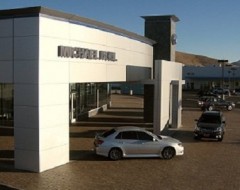 The story of how Subaru became masters of AWD is one of pure chance. In 1970 Tohoku Electric Power Co., northeast Japan’s power company, was looking for vehicles to replace their fleet of Land Cruisers. Employees often had to venture into rugged or snowy terrain to repair power lines, but in regular conditions the Toyotas were deemed too trucky, uncomfortable and inefficient.
The story of how Subaru became masters of AWD is one of pure chance. In 1970 Tohoku Electric Power Co., northeast Japan’s power company, was looking for vehicles to replace their fleet of Land Cruisers. Employees often had to venture into rugged or snowy terrain to repair power lines, but in regular conditions the Toyotas were deemed too trucky, uncomfortable and inefficient.
Fuji Heavy Industires was ahead of the curve in employing front-wheel-drive with the FF-1, while most Japanese cars of its era and size were still rear-wheel-drive. Because their engines (and even spare tires) were mounted over the drive wheels, they garnered a reputation for performing extraordinarily well in snow. A TEPCO manager walked in to a Subaru store one day asking if they would consider making the FF-1 wagon in AWD.
Subaru complied, modifying a handful of them to be fitted with propellor shafts and rear differentials. The diffs and rear axle, in fact, were taken from a Datsun 510 wagon as Nissan owned 20 percent of Subaru at the time (which is also why modern Impreza diffs work so well with RWD Nissans in the aftermarket world). The AWD wagons sat 20mm higher than the FF ones, and with the FF-1 already adopting boxer motors with spare tires sitting atop the engines, the template for all modern Subarus was born.
Just eight custom-built AWD FF-1 wagons were made and sold to TEPCO. The model was nearing the end of its lifecycle, but the vehicles performed so well that FHI decided to sell them straight from the factory like that when the Leone (the JDM name for the DL/GL) debuted in 1971.
